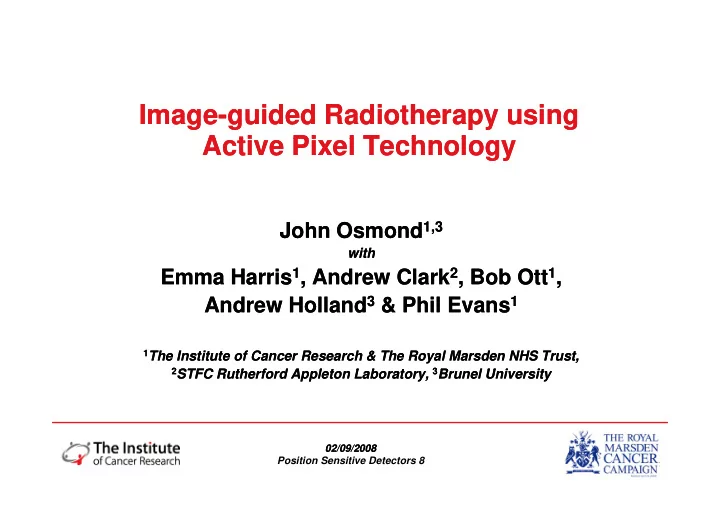

Image Image- -guided Radiotherapy using guided Radiotherapy using A ti Active Pixel Technology Active Pixel Technology A ti Pi Pi l T l T h h l l John Osmond 1,3 1,3 John Osmond with with with with Emma Harris 1 , Andrew Clark , Andrew Clark 2 , Bob Ott , Bob Ott 1 , Emma Harris Andrew Holland 3 & Phil Evans & Phil Evans 1 Andrew Holland Andrew Holland Andrew Holland & Phil Evans & Phil Evans 1 The Institute of Cancer Research & The Royal Marsden NHS Trust, The Institute of Cancer Research & The Royal Marsden NHS Trust, 2 STFC R th 2 STFC Rutherford Appleton Laboratory, STFC Rutherford Appleton Laboratory, 3 Brunel University 3 B STFC R th f f d A d A l t l t L b L b t t B Brunel University l U i l U i it it 02/09/2008 02/09/2008 Position Sensitive Detectors 8
MI 3 Project • Multidimensional Integrated Intelligent Imaging • £4 4m RCUK Basic Technology Research Grant £4.4m RCUK Basic Technology Research Grant • 11 Research Institutes • • Objectives: Objectives: – To extend APS spectral response (e.g. γ -ray, IR, ionising) – To develop on-chip intelligence to improve performance To develop on chip intelligence to improve performance – To customise devices and demonstrate in novel scientific applications (e.g. Medical, Biological, Security, Space Imaging) 02/09/2008 02/09/2008 Position Sensitive Detectors 8
Motivation Motivation • Radiotherapy: Deliver x-ray dose to cancerous tissue whilst minimising the dose to surrounding healthy tissue. minimising the dose to surrounding healthy tissue. • Image data taken at planning, pre-treatment, during treatment: – Position patient, – Verify treatment, – Compensate for motion. Compensate for motion • Current systems (e.g. Video, a-Si) are prone to limitations: Current systems (e.g. Video, a Si) are prone to limitations: – Substantial additional dose sometimes required, – Data not always acquired from beam’s eye view, – Readout, transfer and downstream processing slow. 02/09/2008 02/09/2008 Position Sensitive Detectors 8
CMOS Active Pixel Sensor (APS) CMOS Active Pixel Sensor (APS) • CMOS APS may address many of these limitations: – Single pixel & Region-of-Interest (ROI) readout – Single pixel & Region-of-Interest (ROI) readout, – Intelligence in pixel & Field Programmable Gate Array (FPGA), – Radiation hardness, • Aims: – Build APS (520x520 25 µm pixels, ROI readout, >100 fps), – Incorporate APS into MeV imaging system, I t APS i t M V i i t – Assess imaging performance & compare to standard imager, – Demonstrate simple logic to verify treatment (offline). Demonstrate simple logic to verify treatment (offline) 02/09/2008 02/09/2008 Position Sensitive Detectors 8
Experimental Set Experimental Set- -Up Up • Mirror configuration used in camera EPIDs. • Sensor and electronics remain outside treatment beam Sensor and electronics remain outside treatment beam. 02/09/2008 02/09/2008 Position Sensitive Detectors 8
Head Phantom Head Phantom 0.5s 0.25s 1s 2s 8s 4s 02/09/2008 02/09/2008 Position Sensitive Detectors 8
Contrast to Noise Ratio vs Dose Contrast to Noise Ratio vs Dose • • CNR calculated in square CNR calculated in square region of skull. • CNR = 8.1 x Dose 0.5 . • CNR = 5, Dose = 0.38 cGy. • Time = 1/18 s. 02/09/2008 02/09/2008 Position Sensitive Detectors 8
Relative MTF Relative MTF • • Calculated using the QC3 Calculated using the QC3 phantom: • Reasonable agreement with comparison data (lower f ) comparison data (lower f 50 ) 02/09/2008 02/09/2008 Position Sensitive Detectors 8
IMRT IMRT • Intensity Modulated Radiation Therapy (IMRT): Therapy (IMRT): – Linear accelerator (Linac) produces MeV x-ray p oduces e ay radiation; – Multi-Leaf Collimator (MLC), an array of movable tungsten leaves, shapes the radiation field; radiation field; – Sequence of shaped fields are delivered to form spatially varying dose. 02/09/2008 02/09/2008 Position Sensitive Detectors 8
Total IMRT Dose Total IMRT Dose • Lung treatment delivered in 6 segments over 35 s. • Good agreement between APS and a-Si flat-panel EPID. EPID APS 02/09/2008 02/09/2008 Position Sensitive Detectors 8
Area Area- -Time Analysis Time Analysis • Area above threshold (50% of max) vs time of max) vs. time. • Model based on: – Prescribed leaf positions, Prescribed leaf positions, – Prescribed dose and measured dose-rate, – Leaf speed, acceleration and time delay. • Simple algorithm calculated Si l l ith l l t d offline in software, then eventually online in FPGA. e e tua y o e G 02/09/2008 02/09/2008 Position Sensitive Detectors 8
Edge Edge- -Detection Detection • Threshold at 50% of max • • Mean scalar discrepancy in Mean scalar discrepancy in leaf edges of 0.03 cm. • Mean discrepancy in area of p y < 1% • ROI readout will greatly i improve speed (x26) d ( 26) 02/09/2008 02/09/2008 Position Sensitive Detectors 8
Summary and Future Work Summary and Future Work • Current system can: – Resolve bone structure (~2 cGy) and MLC leaf edges, Resolve bone structure ( 2 cGy) and MLC leaf edges – Verify IMRT to 0.12 s (time), 1 cm 2 (area), 0.3 mm (leaves). • • Limitations: Limitations: – Frame rate required for CNR > 5 is 18 fps (Linac ~ 400 Hz). • Future work: Future work: – Develop system using Large Area Sensor (x20 area), – Evaluate in contact configuration (greater light collection and g (g g resolution, less FOV), – Improve FPGA to utilise ROI, increased frame-rate, on- sensor intelligence. 02/09/2008 02/09/2008 Position Sensitive Detectors 8
Questions? 02/09/2008 02/09/2008 Position Sensitive Detectors 8
Recommend
More recommend